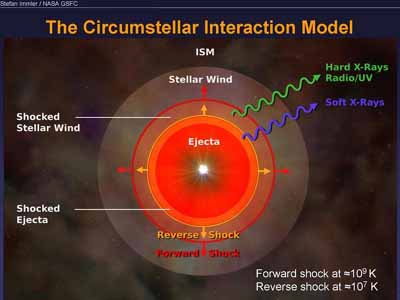Dr. Stefan Immler
The New Scientist article Enigmatic object baffles supernova team said
“An astronomical enigma has been spotted by a team hunting for very distant supernovas for their studies of the early universe.At first glance, the object discovered on 22 February in the constellation Bootes resembled an ordinary supernova. But it kept growing brighter for much too long, and its spectrum was abnormal…
‘It’s a very intriguing object’, says supernova researcher Stefan Immler of the NASA Goddard Space Flight Center in Maryland, US, but he will not rule out the possibility that it might be a supernova.
If it was extremely distant, the expansion of the Universe would relativistically stretch a supernova explosion. We would see a 20-day event stretched to 100 days at a red shift of 4, corresponding to an object about 12 billion light years away seen just 1.5 billion years after the big bang.
That would require an extremely bright supernova, but Immler says that such young stars would explode differently because they contain fewer heavy elements than modern stars.”
Dr. Stefan Immler is an astrophysicist at NASA’s Goddard Space Flight Center (with USRA), a support scientist in the XMM-Newton Guest Observer Facility and a duty scientist in the SWIFT Science Center. He is a member of the Ask an Astronomer project and teaches cosmology at the University of Maryland.
His research is focused on astronomical objects with temperatures of some million of degrees produce radiation predominantly in the X-ray range (photon energies: 0.1 to 100 keV). His projects are aimed at providing a comprehensive insight into the high-energy astrophysical processes taking place in galaxies. Since the Earth’s atmosphere is not transparent for incident X-rays, all observations in the X-ray band must be performed with telescopes and detectors onboard orbiting X-ray observatories high above the Earth’s atmosphere. The most important X-ray astronomy missions currently used by astronomers are the NASA X-ray mission Chandra and the ESA space mission XMM-Newton. Ground- and space-based observations obtained in other wavelength regimes (e.g. radio, optical, UV) are used to supplement his X-ray data.
The emphasis of his studies is on the X-ray emission components in nearby galaxies. X-ray observations of these galaxies are used to study both the discrete X-ray source population (e.g. X-ray binaries, intermediate-mass black holes, supernova remnants, etc) and the diffuse emission component (e.g., hot gas from within the disk and halo of the galaxies). The detections of outflow of hot gas from the disk into the halo of galaxies further enables us to study the dynamical processes that lead to significant heating and enrichment of gas across the disk with heavy elements (due to star formation activities and multiple supernova explosions). Enigmatic ultraluminous X-ray sources were found within some of the studied galaxies. Given the extremely high X-ray luminosities, the short-term variability and their broadband spectral properties, these X-ray sources most likely represent intermediate-mass black hole X-ray binaries located in the spiral arms of the galaxies.
Stefan coauthored Chandra Detection of a Hot Gaseous Corona around the Edge-on Galaxy NGC 4631, An Ultradeep High-Resolution X-Ray Image of M101: The X-Ray Source Population in a Late-Type Spiral, X-ray constraints on ionizing photons from accreting black holes at Z~6, X-Ray Supernovae, and X-Ray, Optical, and Radio Observations of the Type II Supernovae 1999em and 1998S.
Stefan earned a BSc and a MSc in Physics and Astronomy from the Imperial College of Science, Technology & Medicine, London, UK in 1992, did research in space sciences at the Space Science Center, Institute for the Study of Earth, Oceans and Space, University of New Hampshire, Durham, NH in 1993, earned a MSc in Physics from the Ludwig-Maximilians-Universität München, Germany in 1996, and a Ph.D. in astrophysics from the Ludwig-Maximilians-Universität München, Germany in 2000.
Watch his X-Ray Emission from Supernovae in the SWIFT, Chandra and XMM-Newton Era talk!
Read his LinkedIn profile.
